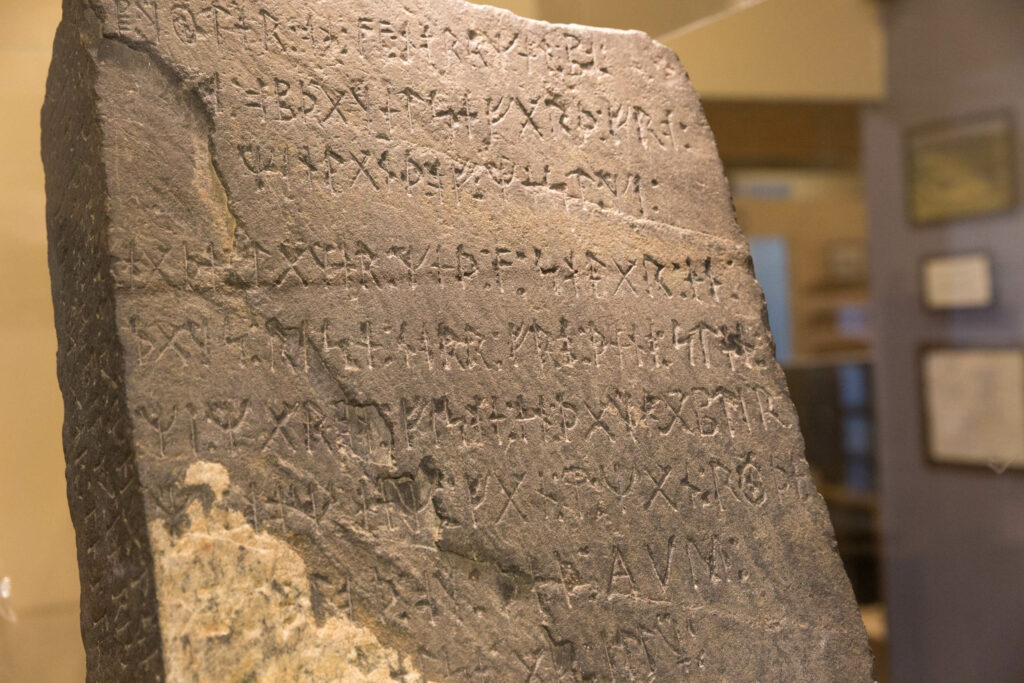Kensington Runestone

By Brent Cordie, Off-Highway Vehicle Specialist Individual Placement / AmeriCorps Member placed at Minnesota Department of Natural Resources, Division of Parks and Trails
Have you ever wondered who could have been the first people to explore Minnesota? Native Americans of course should be the first that come to mind. But then what comes to mind after that? Some probably thought of Christopher Columbus and how he thought he “found India” by sailing across the globe only to find Native Americans instead. Well, this isn’t about those stories this is about how another group of people made the long voyage across the Atlantic. The Vikings!
I found this to be an interesting part of history for Minnesota because it’s surrounded by so much controversy.
The Kensington Runestone has perplexed many people over the years. From scholars to ordinary citizens around the Minnesota area. Some call it one of the greatest discoveries to come out of Minnesota, a part of the history that has happened in our state. Others call a 19th century Hoax that endures into the 21s century.
So, what is the Kensington Runestone? It all started in 1898 with a farmer named Olof Ohman. He was clearing some trees to make room for fields to farm when he discovered the stone under an aspen tree near Kensington, MN 15 miles southwest of Alexandria, MN. He noticed some writing on the stone and his first thought it might be a Native American artifact or something. With further examination done by researchers around the world and across the centuries, this exhaustive quest is still ongoing to this day. For more than 100 years scientists, geologists, and linguists have studied this stone. The question remains how a runic artifact dated 1362 could show up North America?
What does the Runestone say? This is one of the translations of the stone.
“Eight Götalanders and 22 Northmen on (this?) exploration journey from Vinland far to the west. We had a camp by two (shelters?) one day’s journey north from this stone. We were fishing one day. After we came home, found 10 men red from blood and dead. Ave Maria save from evil.
There are 10 men by the inland sea to look after our ships fourteen days journey from this peninsula (or island).
Year 1362”
Ever since the first translation of the runestone there has been disagreement between the authenticity of the stone. Some claim that the words on the stone sound more like a person from the 19th century. More like a person from 19th Century Sweden (Olof Ohman) that could have fabricated the whole thing than a 14 century Viking that traveled across the sea to explore these lands. This all depends on who ever translates the stone though and how much that person has studied 14th artifacts and the language of that era as well.
This could just be a translation issue. That the Runestone could be real and authentic just like Olof Ohman says it is. We have plenty of examples of other ancient texts where translation has changed over the years from its original translation. Somewhere right at the start and somewhere wrong. Only time will tell. This could be one of those cases. I would like to believe this runestone is real but like others I’m skeptical. After researching this topic and visiting the stone myself in person I’m left with this feeling that there is more to this Runestone then we really know. I hope the future brings forth more discoveries surrounding the Runestone.

Sources
en.wikipedia.org/wiki/Kensington_Runestone
www.roadunraveled.com/blog/kensington-runestone-minnesota/